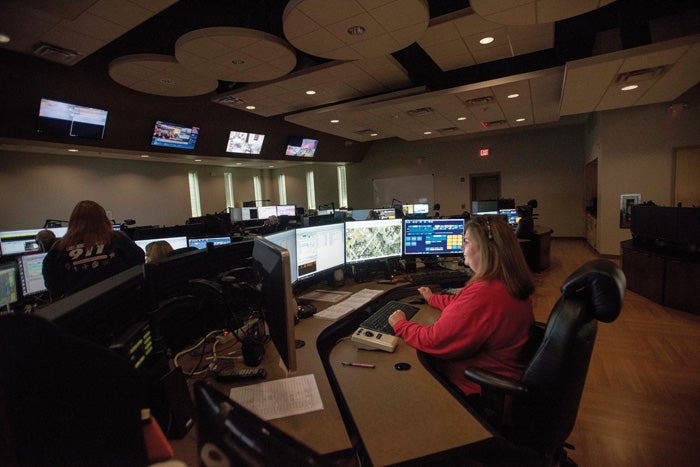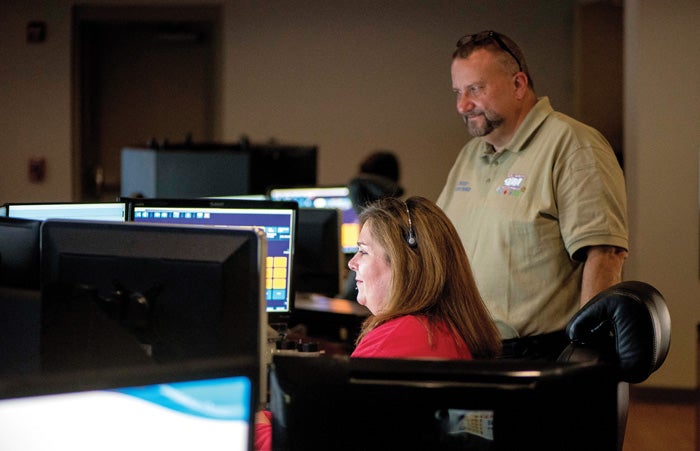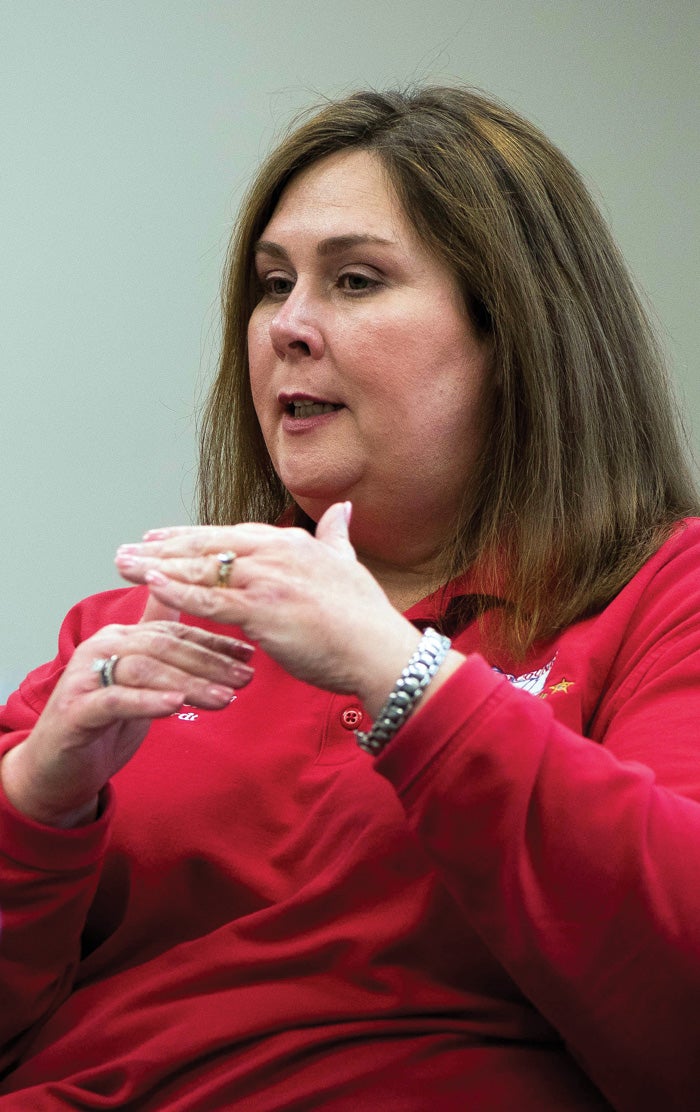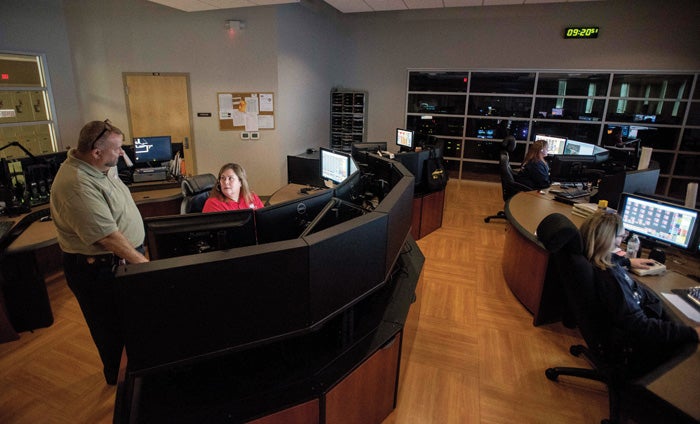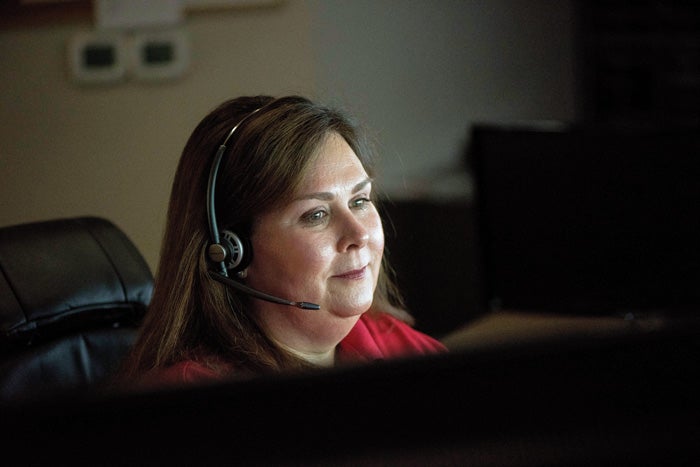In the Trenches: ‘It’s a tough job,’ says 911 supervisor Sherry Earnhardt
Published 12:10 am Monday, November 26, 2018
By Maggie Blackwell
For the Salisbury Post
SALISBURY — Nationwide, 911 centers experience massive turnover as dispatchers struggle to deal with the stress of the job. The Wall Street Journal estimated earlier this year that turnover rates are as high as 66 percent in the field.
Sherry Earnhardt has been on the job for 29 years. Earnhardt, a telecommunications supervisor, has a ready smile and quick wit.
“I didn’t set out to work for 911. The services started in 1987, and I started in 1989. I was looking for something stable with benefits. My dad was a highway patrolman, so our family is pretty law-inclined.
“I started as a jailor and did that for a year. I quickly realized that was not my calling. Boy, I have the ultimate respect for those folks. … You know when you’re 23 years old, you make moves without a plan. Sheriff Martin asked where I was planning on going. I didn’t have a plan. He said, ‘Why don’t you try dispatch for me?’ It was the best thing. Perfect for me. I tried it, I loved it and stuck with it.
“There have been lots of changes for 911 over the years. When I started at the Sheriff’s Office I had a boom mike, a pen, and a map under glass. A telecommunications radio connected to 12-volt battery. I wrote down every call and all the details. I looked up the caller’s location on the map and figured out what district it was and how many cars to send. It was a simpler time, for sure, but miles away from what we do now.”
Rowan County’s modern call center resembles a NASA control room. Each of the 12 consoles has five monitors, all with a specific purpose. Table height raises and lowers. Telecommunicators work 12-hour shifts, and the day can get long, so they can sit or stand as they like through the day.
Supervisor Allen Cress says each console costs $60,000 and has about $230,000 worth of technology.
The county’s 911 center has been open five years and it’s still state-of-the-art. Tucked away in the woods, it’s an ideal location for people with highly stressful jobs. There’s a lot of talk nationally about the stress of working in a 911 center. Earnhardt nods.
“There’s a study that says many telecommunicators have undiagnosed PTSD. I think one of the highest risk factors for telecommuters is vicarious trauma. The emergency personnel can see what’s going on. The telecommunicator is imagining what’s going on. I think sometimes because telecommunicators don’t have the closure, they may carry that. Many work in other areas of public safety — fire departments or rescue squad. I think for those it may be a little easier, helps them to cope.”
Earnhardt says her staff is made up of two kinds of people: folks who have been at it more than 10 years, and those who have just started.
“It’s a tough job. It’s just not for everybody. It takes a person who’s wired correctly to do this job, to handle what they’re hearing, day in and day out, and get up the next morning and come back and ask for more.”
She says each call produces a physical “fight or flight” response for the telecommunicators, but they are required to remain outwardly calm. That can be exhausting.
“It’s really dangerous to fall into the trap of thinking every call is the same,” Earnhardt says. “Every call is different, and it’s vital to treat it like a new case so you can deliver the highest quality service that that caller needs.
“We train our telecommuters to listen to subtle things like background noise or voice pitch. You’d be amazed the nuances a good telecommuter can pick up. Those detections have saved lives before, including law enforcement lives.”
Each team rotates working two weeks of day shifts and two weeks of nights.
“It’s a complicated schedule. But this keeps teams together. We know each other well. We know how to work together. We know each other better than our own families. We become a family and take care of each other.”
She laughs as she recalls personality types on her team.
“We are all type A,” she says. “Telecommunicators are driven people — the kind of people who can take a tornado by the tail and make it sit down and listen. You get nine or 10 type A’s in a room, it’s a lot to handle. You’re stuck in this room for 12 hours with adrenaline pumping. It’s an opportunity for conflict, and it’s a requirement that you have to have pretty thick skin. We tell them if their emotions are on their sleeve, they may not want to work here.”
With a tough job like this, work-life balance is highly important.
“This may sound cruel, but in order to help each person who calls, we have to remember their emergency is not our emergency,” she says. “We can’t take it home. If we felt deeply for every call that came in here, we couldn’t survive. We have the training, tools and techniques to help them, and that’s what we do, every day, all day.”
“We’ve had this conversation a lot, how to maintain longevity. They used to say if you can keep a telecommunicator for five years, you’ll have them for a lifetime. Today they say if you can keep them three years, you’ve done a good job.
“We get them to sign when they start, you’re going to miss holidays, football games, family time, incredible sacrifices. It’s very demanding and takes a special person. It’s as stressful as you let it be. That goes back to ‘their emergency is not your emergency.’”
Earnhardt and Cress say Rowan County 911 pay is about the same as in surrounding areas — lower than some, but with better benefits.
She and Cress say one of the techniques they teach telecommunicators is “repetitive persistence.” If the caller is highly emotional, the telecommunicator can possibly calm the person by repeating the same statement several times.
“It can get the caller to come down to a level where you can talk to them,” Cress says “If they get anxious again, we start again.”
Another technique is voice level. Telecommunicators must sound dispassionate even if they feel empathy for the caller.
“If we raise our voice to their level,” Earnhardt says, “they will continue to escalate. If we keep our voice calm, they will begin to calm as well. Callers may be frustrated with the questions an operator asks, they say, but every question is designed with a specific purpose to result in the best possible outcome for every caller, every time. ”
In the very beginning of 911 service, Cress and Earnhardt say, 100 percent of calls came from landlines with an address indicated. Today, 78 percent come from mobile phones, so operators must ask, “What is your address?”
Even if it’s a landline, they ask in order to verify.
“It’d be a bad day,” Earnhardt observes, “if the responders went to the wrong house.”
This can be frustrating to callers because they feel the questions are delaying the response. Once operators have identified the problem, they can issue the dispatch, but they continue the questions and express care to the caller. Allen compares reality to “NCIS.”
“On TV, they know you are on the second floor at a given address. That’s not reality.”
He says wireless providers have not yet offered the technology to quickly pinpoint a caller’s location.
Five to 10 percent of calls to 911 are true emergencies. The others may not be textbook emergencies, Earnhardt says, but “it’s their emergency. We treat everyone equally, so we want to help them with what they need.”
She cites an example.
“Someone just bought a car they’ve saved for and immediately had a bump-up. They call in, crying so hard you can’t understand what they’re saying. It’s their emergency. But no one is injured, we don’t need to send fire or EMS, they are just upset.
“We may have just had a death call or breaking-and-entering with children in the house, but we get this call, we get the bump-up. There’s a part of our brain where we just compartmentalize what we just handled and help the current caller. Anyone who calls for whatever reason deserves our full attention.”
Today, telecommunicators undergo six months of training, but that wasn’t the case when Earnhardt started.
“I had very little training in the early days. I was scared to death. Today our telecommunicators follow a protocol for each discipline, law, fire, EMS. They have lots of tools to guide them. When I started, it was me in a room, and there I was, with very little training. I had to fly by the seat of my pants and figure it out. Turned out, I have a knack for it.”
She vividly remembers her first calls. Earnhardt had someone with her for her first two shifts and then she was on her own. She made it through her first solo night by herself. Sometime in the second night, she fell apart and called her supervisor, crying. “I just can’t do this,” she wailed.
Her supervisor remained calm. “You are doing this,” he said. “You are fine. Hang in there. You can do this.”
“I tell telecommunicators today, they’re so overwhelmed, I just tell them, ‘Hang in there, one day you’ll walk and it’ll click.’ It happens every single time. If they can hang in there until it happens, it’ll happen.”
Earnhardt described the typical 911 operator.
“Telecommuters, for all their rough edges, have servants’ hearts. When we interview people for this job, we ask, ‘Why do you want to work here?’ — and the universal answer is ‘to help people.’ We could almost remove that question from the interview.”
Earnhardt knows that compassion for others must drive their work. No stranger to tragedy, she and her husband lost their 3-month-old baby, Meagan, to sudden infant death syndrome almost 30 years ago. It happened on Christmas Eve.
“Her brief life drives me to compassion for the many callers who suffer through the loss of a child. In retrospect, I realize that many telecommunicators here have a story that affects them deeply, and it instills compassion and empathy in them.”
Earnhardt has a busy life, working full time and volunteering significant hours with a nonprofit organization that helps rescue and restore victims of human trafficking.
“(Human trafficking) is a horrible crisis. We find so much hope there to find the girls and give them a future. We’ve been doing it for 10 years now. When I first started, it was very grassroots. There was nothing for telecommunicators but it was taught in Basic Law Enforcement Training. I wrote my own curriculum and began teaching law enforcement and telecommunicators. I just have so much passion about this.
“Those nuances I mentioned earlier — sometimes our folks can pick up that it’s a human trafficking situation. So I teach around the state to help folks pick up on that.”
Both of Earnhardt’s brothers are pastors.
“Faith is a very important thing for me,” she says. “I pray for my crew and for the people who call. My faith balances me. I’m never without hope with Jesus Christ. No matter how bad those situations are, no matter what comes across my path, I have hope. It keeps me going, keeps me strong, keeps me encouraged, keeps me grateful.”
Her parents were great people, she says.
“They taught us very early in life to serve the Lord and do things for other people, and that’s where joy comes from.”
She gives all the credit for her team to Cress.
“We have a hidden gem here in Rowan County. No one will ever realize the amount of work and effort behind the scenes to be sure our telecommunicators are educated. The coordination between the departments, law enforcement, fire, EMS, never stops evolving, never stops changing.”
Cress attends conferences every year to learn best practices and upcoming trends at 911 centers. Locally, the Telecommunications Advisory Board, which includes representatives of all the agencies, meets bimonthly. The board’s feedback gives Cress the information to keep improving the center.
“If you’re coming here looking to be a star, or get a pat on the back, that’s not gonna happen,” Earnhardt says. “We are supposed to be invisible — until one of us makes a mistake. That goes on the news. You are invisible until you make a mistake.”
Earnhardt plans to retire in three years; Cress, in seven. They are working today to groom leaders to follow them.
Earnhardt says she does have good days at work.
“I can think of a lot of instances where when I went home I was so proud of the job I did,” she says. “It makes it worth it. I knew somebody was alive that day because I went to work. That’s a pretty good contribution to society.”
She smiles. “It’s a pretty good feeling.”


